BOOK OF HOURS, use of Rouen, in Latin and French, ILLUMINATED MANUSCRIPT ON VELLUM
BOOK OF HOURS, use of Rouen, in Latin and French, ILLUMINATED MANUSCRIPT ON VELLUM [Rouen, c.1470] 194 x 125mm. 139 leaves, apparently COMPLETE,1 1 2 , 2 8 , 3 4 , 4 2 , 5 8 , 6 6 , 7-10 8 , 11 2 , 12 8 , 13 6 , 14 4 , 15 8 , 16 4 , 17-19 8 , 20 2 , 21 8 , 22 2 , two blank ruled leaves ff. 129 and 139, 16 lines written in a gothic bookhand in black ink between two verticals and 23 horizontals ruled in pale red, justification: 96 x 60mm, rubrics in red, one-line initials of burnished gold on grounds of blue or red with white pen decoration infill, two-line initials of blue or red with contrasting infill and white pen decoration on burnished gold grounds, FOUR PAGES WITH FULL-PAGE BORDERS, three with accompanying large four- and five-line initials, and each two-line initial with panel border of acanthus and naturalistic flower and fruit sprays interspersed with hairline tendrils and bezants, FOURTEEN LARGE ARCH-TOPPED MINIATURES WITH FULL-PAGE BORDERS in the same style, some with roundels containing flowers and strawberries growing from the ground, birds, a squirrel, hybrid creatures, with accompanying three-line initials (occasional damp-staining, smudging or pigment loss affecting a few miniatures, marginal staining to three leaves, a few modern pencil inscriptions). Early-18th century French red morocco gilt in the style of Antoine-Michel Padeloup Le Jeune (1685-1758), gilt triple fillets and fleurons framing covers and floret rolls framing the doublure, spine tooled in six compartments, one with green morocco lettering-piece, with central pomegranate tool surrounded by dentelle, flowers, stars and pointillé work, g.e., Buntpapier floral end-papers (slightly scuffed). Green morocco solander box. PROVENANCE: 1. The Paris Calendar adapted for Rouen use with the feast days of St Marcial (3 July), St Sauveur (6 August), and St Romaing (23 October) in gold, inclusion of St Austreberta in the Litany, and the use of the Office of the Virgin indicate that the book was made in Rouen. Though the Obsecro te has masculine forms, a portrait of a female owner appears in the miniature opening the final prayer, Doulce Dame . 2. Bernard Quaritch, booksellers: receipt for £80, dated 19 February 1913. 3. Isabelle Corwith Cramer (1861-1954), wife of the Chicago mining supplier Ambrose Cramer (her bookplate inside upper cover); her stepson was the architect Ambrose Cramer Jr. 4. [Alan G. Thomas], typescript description of the book with pen annotations, with his price code, erased pencil inscription 'by far best I've ever owned' on verso of front fly-leaf. CONTENT: Calendar in French ff.1-12v; Gospel extracts ff.13-18v; Obsecro te ff.19-22v; O Intemerata ff.22v-26; [f. 26v blank]; Office of the Virgin, use of Rouen, ff.27-74v: matins f.27, lauds f.37v, prime f.49, terce f.54, sext f.57v, none f.61, vespers f.64v, compline f.70; Penitential Psalms and Litany ff.75-91v; [f.92 blank]; Hours of the Cross ff.93-96; Hours of the Holy Spirit ff.96v-99v; Office of the Dead ff.100-129v; [f.130 blank]; Doulce Dame ff.131-138v; [f.139 blank]. ILLUMINATION: This delightful Book of Hours was illuminated by a skilled artist in the workshop of the Master of the Rouen Echevinage, whose style dominated Rouennais book production in the third quarter of the 15th century. The Master is known for his richly patterned fabrics, complex combinations of architecture and landscape, and embellishment of narrative with additional details. All these features are evident in the present lot. The luminous palette makes lavish use of gold both for highlighting and for representing gold in textiles and metalwork; the contrasting qualities of liquid and burnished gold are exploited in miniatures and borders. The Master's successful compositions are repeated with engaging variations such as the shepherd and shepherdess too playfully occupied to notice the angel above them on f.54. The Master of the Rouen Echevinage, sometimes known as the Master of Geneva Latini, is named after
BOOK OF HOURS, use of Rouen, in Latin and French, ILLUMINATED MANUSCRIPT ON VELLUM
BOOK OF HOURS, use of Rouen, in Latin and French, ILLUMINATED MANUSCRIPT ON VELLUM [Rouen, c.1470] 194 x 125mm. 139 leaves, apparently COMPLETE,1 1 2 , 2 8 , 3 4 , 4 2 , 5 8 , 6 6 , 7-10 8 , 11 2 , 12 8 , 13 6 , 14 4 , 15 8 , 16 4 , 17-19 8 , 20 2 , 21 8 , 22 2 , two blank ruled leaves ff. 129 and 139, 16 lines written in a gothic bookhand in black ink between two verticals and 23 horizontals ruled in pale red, justification: 96 x 60mm, rubrics in red, one-line initials of burnished gold on grounds of blue or red with white pen decoration infill, two-line initials of blue or red with contrasting infill and white pen decoration on burnished gold grounds, FOUR PAGES WITH FULL-PAGE BORDERS, three with accompanying large four- and five-line initials, and each two-line initial with panel border of acanthus and naturalistic flower and fruit sprays interspersed with hairline tendrils and bezants, FOURTEEN LARGE ARCH-TOPPED MINIATURES WITH FULL-PAGE BORDERS in the same style, some with roundels containing flowers and strawberries growing from the ground, birds, a squirrel, hybrid creatures, with accompanying three-line initials (occasional damp-staining, smudging or pigment loss affecting a few miniatures, marginal staining to three leaves, a few modern pencil inscriptions). Early-18th century French red morocco gilt in the style of Antoine-Michel Padeloup Le Jeune (1685-1758), gilt triple fillets and fleurons framing covers and floret rolls framing the doublure, spine tooled in six compartments, one with green morocco lettering-piece, with central pomegranate tool surrounded by dentelle, flowers, stars and pointillé work, g.e., Buntpapier floral end-papers (slightly scuffed). Green morocco solander box. PROVENANCE: 1. The Paris Calendar adapted for Rouen use with the feast days of St Marcial (3 July), St Sauveur (6 August), and St Romaing (23 October) in gold, inclusion of St Austreberta in the Litany, and the use of the Office of the Virgin indicate that the book was made in Rouen. Though the Obsecro te has masculine forms, a portrait of a female owner appears in the miniature opening the final prayer, Doulce Dame . 2. Bernard Quaritch, booksellers: receipt for £80, dated 19 February 1913. 3. Isabelle Corwith Cramer (1861-1954), wife of the Chicago mining supplier Ambrose Cramer (her bookplate inside upper cover); her stepson was the architect Ambrose Cramer Jr. 4. [Alan G. Thomas], typescript description of the book with pen annotations, with his price code, erased pencil inscription 'by far best I've ever owned' on verso of front fly-leaf. CONTENT: Calendar in French ff.1-12v; Gospel extracts ff.13-18v; Obsecro te ff.19-22v; O Intemerata ff.22v-26; [f. 26v blank]; Office of the Virgin, use of Rouen, ff.27-74v: matins f.27, lauds f.37v, prime f.49, terce f.54, sext f.57v, none f.61, vespers f.64v, compline f.70; Penitential Psalms and Litany ff.75-91v; [f.92 blank]; Hours of the Cross ff.93-96; Hours of the Holy Spirit ff.96v-99v; Office of the Dead ff.100-129v; [f.130 blank]; Doulce Dame ff.131-138v; [f.139 blank]. ILLUMINATION: This delightful Book of Hours was illuminated by a skilled artist in the workshop of the Master of the Rouen Echevinage, whose style dominated Rouennais book production in the third quarter of the 15th century. The Master is known for his richly patterned fabrics, complex combinations of architecture and landscape, and embellishment of narrative with additional details. All these features are evident in the present lot. The luminous palette makes lavish use of gold both for highlighting and for representing gold in textiles and metalwork; the contrasting qualities of liquid and burnished gold are exploited in miniatures and borders. The Master's successful compositions are repeated with engaging variations such as the shepherd and shepherdess too playfully occupied to notice the angel above them on f.54. The Master of the Rouen Echevinage, sometimes known as the Master of Geneva Latini, is named after
.jpg)
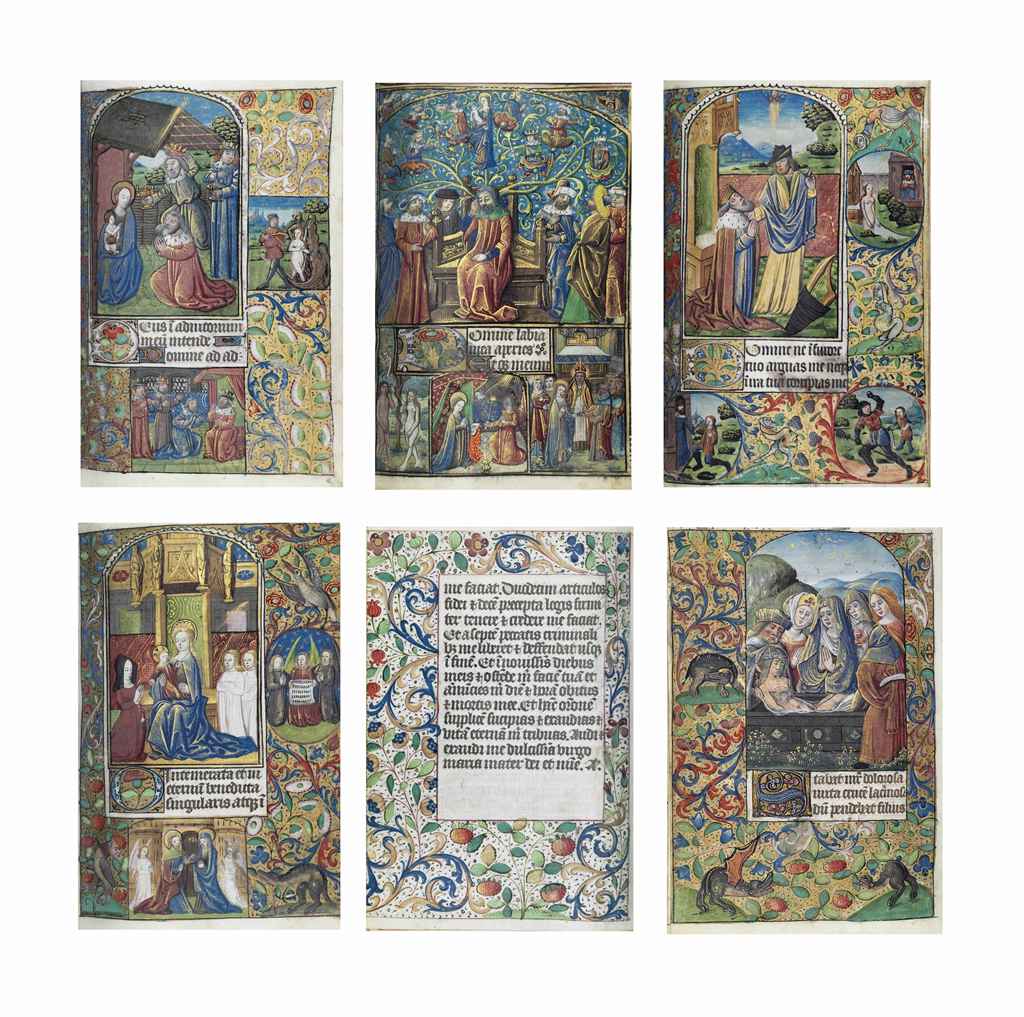
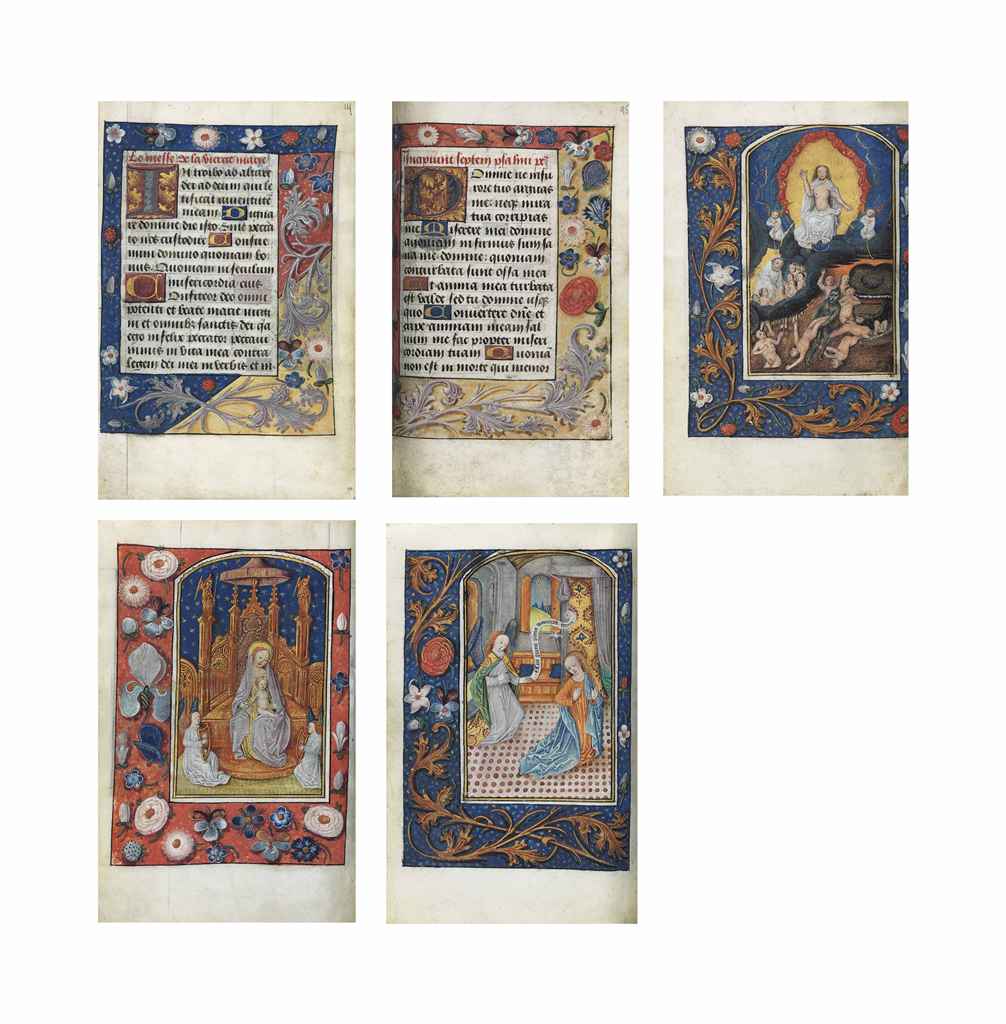
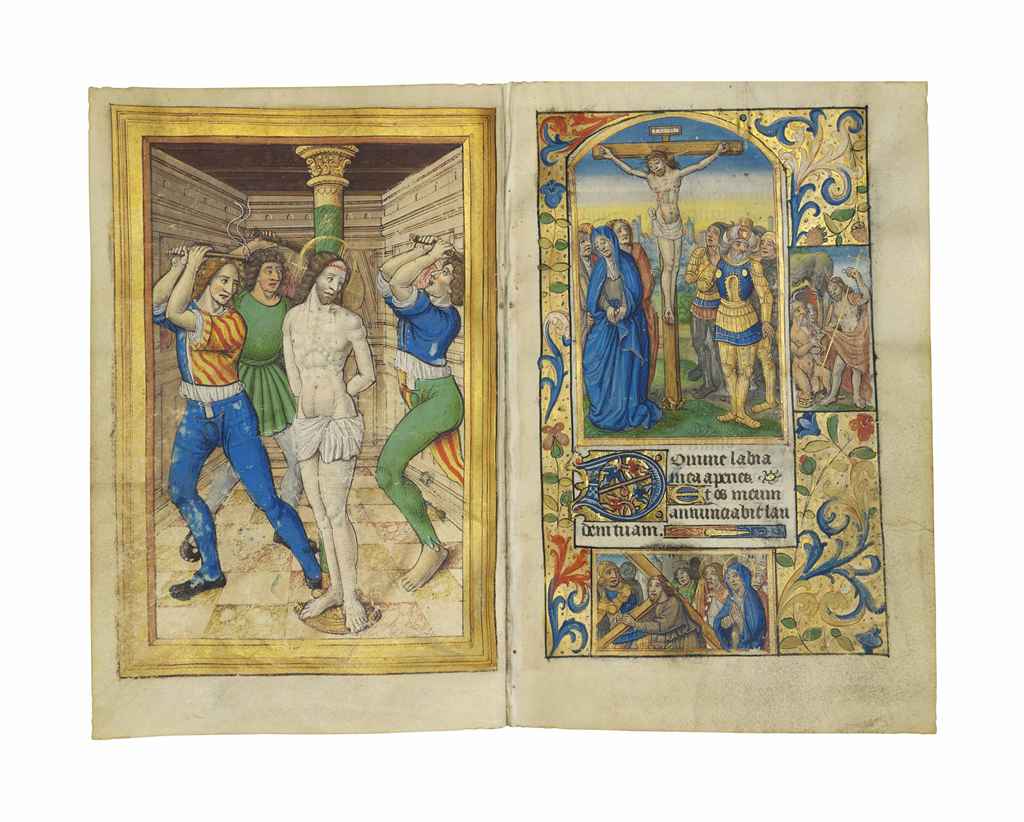
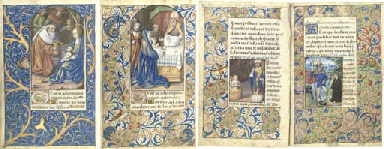
.jpg)
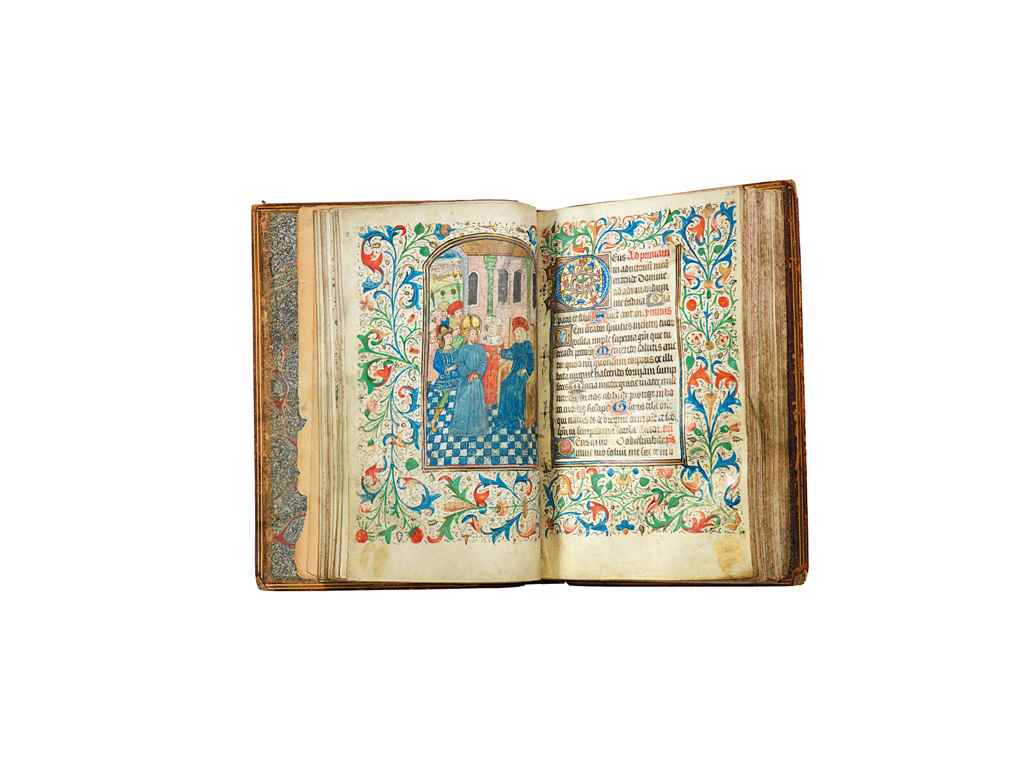


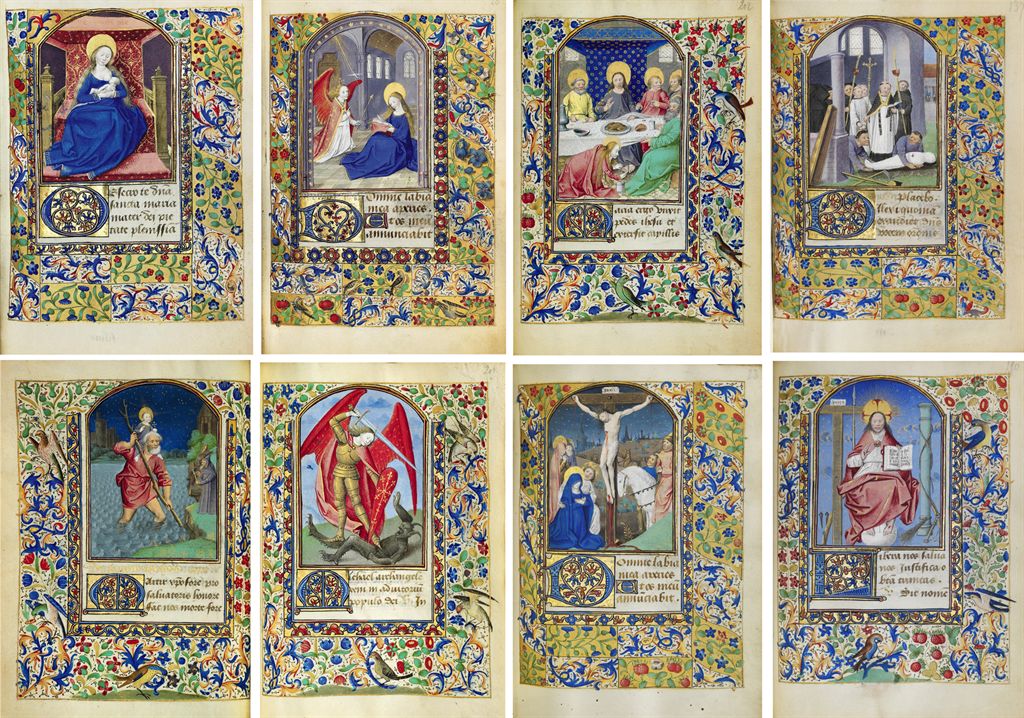
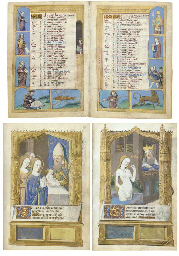
.jpg)


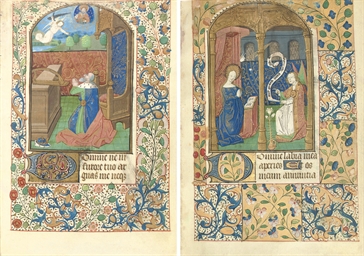
Try LotSearch and its premium features for 7 days - without any costs!
Be notified automatically about new items in upcoming auctions.
Create an alert